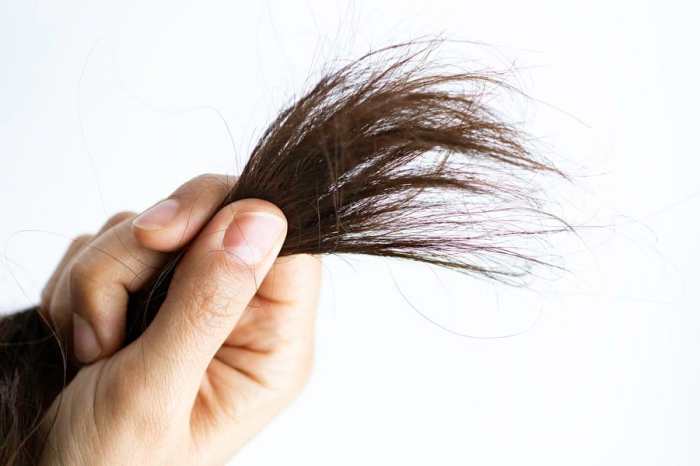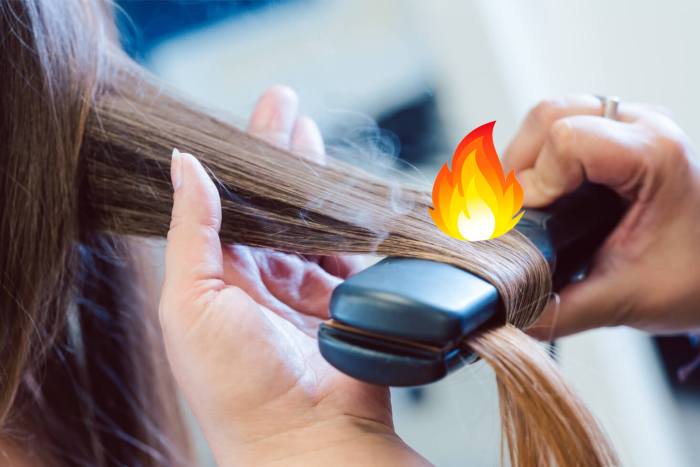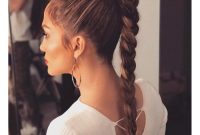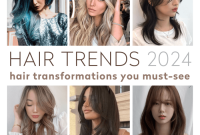Healthy, lustrous hair is a reflection of overall well-being. However, environmental factors, heat styling, and improper care can wreak havoc on our tresses, leaving them dry, damaged, and in need of TLC. This comprehensive guide delves into the causes and prevention of dry and damaged hair, the impact of heat styling, and effective repair strategies.
We’ll also explore hair care products tailored for damaged hair, protective hairstyles, and lifestyle factors that influence hair health.
Whether you’re dealing with dryness, breakage, or heat damage, this guide provides practical tips, expert advice, and DIY remedies to help you restore your hair’s health and vitality. Let’s embark on a journey to rediscover the beauty and resilience of your crowning glory.
Hair Care for Dry and Damaged Hair

Dry and damaged hair is a common problem that can be caused by a variety of factors, including heat styling, chemical treatments, and environmental factors. Dry hair lacks moisture and is often brittle and prone to breakage, while damaged hair has been structurally compromised and may have lost its natural shine and elasticity.
There are a number of things you can do to prevent dry and damaged hair, including:
- Limit heat styling.
- Use a heat protectant spray when you do use heat styling tools.
- Get regular trims to remove split ends.
- Avoid harsh chemicals, such as those found in some hair dyes and perms.
- Protect your hair from the sun and wind.
- Eat a healthy diet that includes plenty of fruits, vegetables, and whole grains.
- Drink plenty of water.
If your hair is already dry and damaged, there are a number of things you can do to improve its condition, including:
- Use a gentle shampoo and conditioner.
- Deep condition your hair regularly.
- Use a leave-in conditioner.
- Avoid brushing your hair when it is wet.
- Get regular trims to remove split ends.
- Protect your hair from the sun and wind.
- Eat a healthy diet that includes plenty of fruits, vegetables, and whole grains.
- Drink plenty of water.
With proper care, you can restore your hair to its former health and beauty.
Heat Damaged Hair
Heat styling tools, such as hair dryers, flat irons, and curling wands, can cause significant damage to hair. The high temperatures used in these tools can break down the hair’s protein structure, leading to dryness, brittleness, and split ends. Overuse of heat styling tools can also lead to hair loss.To
avoid heat damage, it is important to limit the use of heat styling tools and to use them on a low heat setting. It is also important to use a heat protectant spray before using heat styling tools. Heat protectant sprays create a barrier between the hair and the heat, helping to reduce damage.If
your hair has already been damaged by heat, there are a number of things you can do to repair it. Deep conditioning treatments can help to restore moisture and strength to damaged hair. You can also use a leave-in conditioner or hair mask to help protect your hair from further damage.
Common Heat Styling Mistakes
There are a number of common heat styling mistakes that can lead to hair damage. These include:
- Using heat styling tools on wet hair.
- Using heat styling tools on a high heat setting.
- Overusing heat styling tools.
- Not using a heat protectant spray.
- Not letting your hair cool down before brushing it.
Methods for Repairing Heat Damaged Hair
There are a number of methods you can use to repair heat damaged hair. These include:
- Deep conditioning treatments.
- Leave-in conditioners.
- Hair masks.
- Trimming split ends.
- Using a heat protectant spray.
- Limiting the use of heat styling tools.
Repairing Damaged Hair
Hair damage is a common problem caused by various factors such as heat styling, chemical treatments, and environmental stressors. Understanding the science behind hair damage and repair is crucial for effective treatment.
Hair is composed primarily of a protein called keratin, which gives it strength and structure. Damage to the keratin structure weakens hair, making it prone to breakage, split ends, and dryness. Heat and chemical treatments can break down keratin bonds, while environmental factors like UV radiation and pollution can contribute to oxidative stress, further damaging hair.
Effective Treatments for Repairing Damaged Hair
- Professional Hair Treatments: Keratin treatments and Olaplex are professional treatments that repair and strengthen damaged hair by replenishing keratin and rebuilding broken bonds.
- Deep Conditioning: Deep conditioners penetrate the hair shaft, providing intense hydration and nourishment. They help repair damaged cuticles and improve hair elasticity.
- Leave-in Conditioners: Leave-in conditioners coat the hair, protecting it from further damage and providing ongoing hydration.
DIY Hair Masks and Remedies for Damaged Hair
In addition to professional treatments, there are several DIY hair masks and remedies that can help repair damaged hair:
- Coconut Oil Mask: Coconut oil is rich in fatty acids that penetrate the hair shaft, providing deep conditioning and strengthening.
- Avocado Mask: Avocados are rich in vitamins, minerals, and antioxidants that nourish and repair damaged hair.
- Honey Mask: Honey is a natural humectant that attracts moisture to the hair, hydrating and softening it.
Hair Care Products for Damaged Hair
Damaged hair requires specialized care to restore its health and vitality. Choosing the right hair care products is crucial for effective repair and protection.
Understanding Hair Care Ingredients
Various ingredients in hair care products target specific hair concerns. Here’s a brief overview of their benefits and drawbacks:
- Protein: Essential for strengthening and repairing damaged hair. However, excessive use can lead to protein overload, making hair brittle.
- Keratin: A natural protein that fills in damaged areas, improving hair’s texture and shine. It can be derived from plants or animals.
- Moisturizers: Hydrate and soften damaged hair. Common moisturizers include oils (argan, coconut), butters (shea, cocoa), and humectants (glycerin, hyaluronic acid).
- Conditioners: Smooth the hair cuticle, reducing tangles and frizz. Silicones and quats are common conditioning agents, but silicones can build up on hair.
- Heat protectants: Create a barrier against heat styling tools, preventing further damage. Look for products with dimethicone, cyclopentasiloxane, or thermal shield technology.
Choosing the Right Products
Selecting the right hair care products depends on the extent of hair damage and individual hair type.
- For severely damaged hair: Opt for products containing high concentrations of protein, keratin, and deep conditioners to rebuild and strengthen hair.
- For moderately damaged hair: Use products with a balance of protein, moisturizers, and conditioners to repair and protect hair without overloading it.
- For dry and brittle hair: Focus on products rich in moisturizers to hydrate and prevent breakage. Avoid protein-heavy products that can further dry out hair.
It’s advisable to consult a professional hairstylist for personalized product recommendations based on your specific hair needs.
Protective Hairstyles for Damaged Hair

Damaged hair requires special care and protection to prevent further damage and promote healthy growth. Protective hairstyles offer an effective way to shield hair from environmental stressors, reduce breakage, and allow damaged hair to repair itself.
Benefits of Protective HairstylesProtective hairstyles provide numerous benefits for damaged hair, including:
-
-*Reduced Breakage
By keeping hair contained and protected, protective hairstyles minimize friction and tangling, which can cause breakage.
-
-*Moisture Retention
Protective styles help trap moisture within the hair, preventing dryness and promoting hydration.
-*Reduced Heat Damage
Protective hairstyles cover and shield hair from direct heat from styling tools, reducing the risk of heat damage.
-*Encouragement of Healthy Growth
By protecting hair from damage, protective hairstyles create an optimal environment for healthy hair growth.
Protective Hairstyle OptionsVarious protective hairstyles can be used for damaged hair, such as:
-
-*Braids
Braids of all types, including cornrows, box braids, and French braids, effectively contain hair and prevent tangles.
-
-*Twists
Similar to braids, twists involve wrapping two strands of hair together, creating a protective barrier.
-*Buns
Buns gather hair into a compact shape, reducing friction and exposure to the elements.
-*Scarves and Wraps
Silk or satin scarves and wraps can be tied around the hair to protect it from friction and moisture loss.
Styling and Maintenance Tips
-*Reduced Breakage
By keeping hair contained and protected, protective hairstyles minimize friction and tangling, which can cause breakage.
-*Moisture Retention
Protective styles help trap moisture within the hair, preventing dryness and promoting hydration.
-*Reduced Heat Damage
Protective hairstyles cover and shield hair from direct heat from styling tools, reducing the risk of heat damage.
-*Encouragement of Healthy Growth
By protecting hair from damage, protective hairstyles create an optimal environment for healthy hair growth.
-
-*Braids
Braids of all types, including cornrows, box braids, and French braids, effectively contain hair and prevent tangles.
-*Twists
Similar to braids, twists involve wrapping two strands of hair together, creating a protective barrier.
-*Buns
Buns gather hair into a compact shape, reducing friction and exposure to the elements.
-*Scarves and Wraps
Silk or satin scarves and wraps can be tied around the hair to protect it from friction and moisture loss.
Styling and Maintenance Tips
To style and maintain protective hairstyles for damaged hair effectively:
-
-*Use Gentle Products
Opt for sulfate-free shampoos and conditioners designed for damaged hair.
-*Moisturize Regularly
Apply leave-in conditioners or hair oils to keep hair hydrated.
-*Avoid Heat Styling
Limit the use of heat styling tools and opt for air-drying or low-heat settings when necessary.
-*Protect from the Elements
Wear a hat or scarf to protect hair from sun damage and cold weather.
-*Get Regular Trims
Trim damaged ends regularly to prevent split ends from traveling up the hair shaft.
Lifestyle Factors Affecting Hair Health

Hair health is influenced not only by hair care practices but also by overall lifestyle choices.
Diet, stress, and sleep play significant roles in maintaining healthy hair.
Diet
Proper nutrition is essential for healthy hair growth. A balanced diet rich in essential vitamins and minerals, such as biotin, iron, zinc, and vitamin C, nourishes the hair follicles and promotes healthy hair growth. Incorporating foods like leafy greens, fruits, lean protein, and whole grains into your diet can help improve hair health.
Stress
Stress can have a detrimental impact on hair health. When the body is under stress, it produces the hormone cortisol, which can lead to hair loss and thinning. Managing stress through relaxation techniques such as yoga, meditation, or spending time in nature can help reduce cortisol levels and improve hair health.
Sleep
Adequate sleep is crucial for overall health, including hair health. During sleep, the body releases hormones that promote hair growth. Aim for 7-9 hours of quality sleep each night to support healthy hair growth and prevent hair loss.
Outcome Summary
Restoring damaged hair requires a multifaceted approach that addresses both internal and external factors. By adopting a holistic hair care regimen, incorporating protective hairstyles, and making healthy lifestyle choices, you can effectively repair and revitalize your tresses. Remember, healthy hair is a reflection of a healthy body and mind.
Embrace the tips and strategies Artikeld in this guide, and watch your hair regain its strength, shine, and vibrancy.
Common Queries
Q: What are the key causes of dry and damaged hair?
A: Exposure to harsh environmental factors like UV rays, pollution, and dry air, as well as chemical treatments, heat styling, and improper hair care practices can all contribute to dry and damaged hair.
Q: How can I prevent heat damage to my hair?
A: Use heat protectant products before styling, limit the use of hot tools, and opt for lower heat settings when blow-drying or straightening your hair.
Q: What are some effective DIY hair masks for repairing damaged hair?
A: DIY hair masks using ingredients like coconut oil, avocado, honey, and yogurt can provide deep conditioning and nourishment to damaged hair.
Q: How often should I wash my hair if it’s dry and damaged?
A: Washing your hair too frequently can strip it of its natural oils, exacerbating dryness. Aim to wash your hair every 2-3 days, or as needed.
Q: Are there any protective hairstyles that can minimize damage to dry and damaged hair?
A: Protective hairstyles like braids, buns, and head wraps can help reduce friction and breakage, providing a protective barrier for damaged hair.



